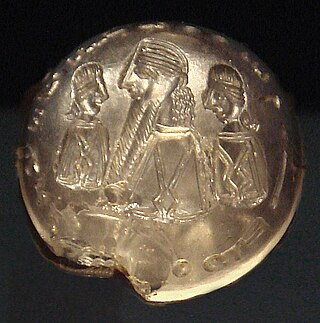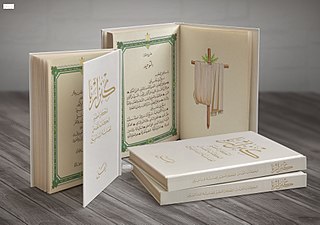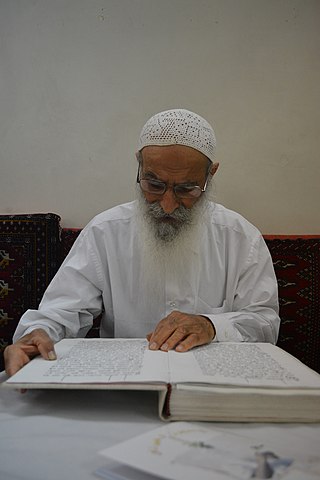Related Research Articles

Manichaeism is a former major world religion, founded in the 3rd century CE by the Parthian prophet Mani, in the Sasanian Empire.

Mandaeans, also known as Mandaean Sabians or simply as Sabians, are an ethnoreligious group who are followers of Mandaeism. They believe that John the Baptist was the final and most important prophet. They may have been among the earliest religious groups to practice baptism, as well as among the earliest adherents of Gnosticism, a belief system of which they are the last surviving representatives today. The Mandaeans were originally native speakers of Mandaic, an Eastern Aramaic language, before they nearly all switched to Iraqi Arabic or Persian as their main language.
"The Thunder, Perfect Mind" is a text originally discovered in the Nag Hammadi library in 1945. It follows a poetic structure, and has received scholarly attention for its gnomic style and unclear subject. It speaks about the divine in paradoxical terms, as both honored and cursed, as life and death, and as both the cause of peace and war. The poem also emphasizes the idea that the divine exists both inside and outside of oneself, and that one's judgment and salvation are dependent on their relationship to the divine. It offers a unique perspective on the nature of the divine and the individual's relationship to it, and it highlights the idea of duality and the interconnectedness of opposing forces.

Mandaeism, sometimes also known as Nasoraeanism or Sabianism, is a Gnostic, monotheistic and ethnic religion with Greek, Iranian, and Jewish influences. Its adherents, the Mandaeans, revere Adam, Abel, Seth, Enos, Noah, Shem, Aram, and especially John the Baptist. Mandaeans consider Adam, Seth, Noah, Shem and John the Baptist prophets, with Adam being the founder of the religion and John being the greatest and final prophet.

The Qolastā, Qulasta, or Qolusta is the canonical prayer book of the Mandaeans, a Gnostic ethnoreligious group from Iraq and Iran. The Mandaic word qolastā means "collection". The prayerbook is a collection of Mandaic prayers regarding baptisms (masbuta) and other sacred rituals involved in the ascension of the soul (masiqta).

The Elcesaites, Elkasaites, Elkesaites or Elchasaites were an ancient Jewish Christian sect in Lower Mesopotamia, then the province of Asoristan in the Sasanian Empire that was active between 100 and 400 CE. The members of this sect, which originated in the Transjordan, performed frequent baptisms for purification and had a Gnostic orientation.

Charles Robert Cecil Augustine Allberry was an English Egyptologist and Coptic scholar. He was best known during his lifetime for his 1938 partial translation of A Manichean Psalm-Book, and posthumously as the model for C. P. Snow's character, Roy Calvert, introduced in The Light and the Dark (1947). Allberry served in the Royal Air Force in the Second World War and was shot down and killed in 1943.
The Manichaean Psalm Book or Manichaean Psalter is a Manichaean text written in Coptic. It is believed to have been compiled in the late 3rd century or the mid-4th century. Excavated in 1929 as part of the Medinet Madi library, the Psalm Book is believed to contain remnants of some of the earliest extant Manichaean literature.

Asoristan was the name of the Sasanian province of Assyria and Babylonia from 226 to 637.
An uthra or ʿutra is a "divine messenger of the light" in Mandaeism. Charles G. Häberl and James F. McGrath translate it as "excellency". Jorunn Jacobsen Buckley defines them as "Lightworld beings, called 'utras ." Aldihisi (2008) compares them to the yazata of Zoroastrianism. According to E. S. Drower, "an 'uthra is an ethereal being, a spirit of light and Life."

The Left Ginza is one of the two parts of the Ginza Rabba, the longest and the most important holy scripture of Mandaeism. The other part of the Ginza Rabba is the Right Ginza.
Mandaean cosmology is the Gnostic conception of the universe in the religion of Mandaeism.
Dinanukht is a mythological character in the Ginza Rabba, one of the main religious scriptures of Mandaeism, who is portrayed as an anthropomorphic book. Book 6 of the Right Ginza describes his ascension to the World of Light.
In Mandaeism, Adathan and Yadathan are a pair of uthras who stand at the Gate of Life in the World of Light, praising and worshipping Hayyi Rabbi. In the Ginza Rabba and Qolasta, they are always mentioned together. Book 14 of the Right Ginza mentions Adathan and Yadathan as the guardians of the "first river".
In Mandaeism, Nidbai is an uthra who serves as one of the two guardian spirits of Piriawis, the heavenly yardna (river) in the World of Light. In the Ginza Rabba and Qolasta, he is usually mentioned together with Shilmai.
In Mandaeism, Simat Hayyi or Simat Hiia, the personification of life, is an uthra from the World of Light who is married to Yawar Ziwa.
The Mandaic word mana (ࡌࡀࡍࡀ) is a term that is roughly equivalent to the philosophical concept of nous. It has been variously translated as "mind", "soul", "treasure", "Garment", "Intelligence", "Heart", "Spirit", "Being"; or alternatively as "nous", "consciousness", or "vessel".
Daily prayer in Mandaeism, called brakha ࡁࡓࡀࡊࡀ in Mandaic or occasionally birukta (birukhta), consists of set prayers that are recited three times per day. Mandaeans stand facing north while reciting daily prayers. Unlike in Islam and Coptic Orthodox Christianity, prostration is not practiced.
In Mandaeism, Yufin-Yufafin or Yupin-Yupapin is an uthra in the World of Light. In the Ginza Rabba, Yufin-Yufafin is mentioned in Books 3 and 5.4 of the Right Ginza and Book 1 of the Left Ginza, whereas "Yufin-Uthra" is mentioned in Book 4 of the Right Ginza. He is also mentioned in many Qolasta prayers, including prayers 5, 9, 22, 28, 46, 77, 105, and 171, in which he is often mentioned along with uthras such as Sam Mana Smira and Nbaṭ.
In Sethian Gnostic texts, Yesseus Mazareus Yessedekeus is the personification of the Living Water. He is mentioned in the Nag Hammadi tractates of the Holy Book of the Great Invisible Spirit, Zostrianos, and Apocalypse of Adam.
References
- ↑ The Christian Centuries: A New History of the Catholic Church. McGraw-Hill. 1964. p. 47. ISBN 9780809102754 . Retrieved 5 July 2018.
- ↑ Allberry, C. R. C., editor & translator, with a contribution by Hugo Ibscher, Coptic Manichaean Psalm-book part II, W. Kohlhammer, Stuttgart, 1938. The Psalms of Thomas occupy pages 203-227.
- ↑ Nagel, Peter (2011), "Thomas, The Manichaean Psalms of", Religion Past and Present, Brill, doi:10.1163/1877-5888_rpp_sim_026055, ISBN 9789004146662 , retrieved 2021-12-08
- 1 2 Säve-Söderbergh, Torgny (1949). Studies in the Coptic Manichaean Psalm-book. Uppsala: Almqvist & Wiksells Boktryckeri AB. OCLC 5687415.
- ↑ Lofts, Mark J. (2013). "How Old are the Psalms of Thomas and what is their Relation to the Gospel of Thomas?" In ARAM 25:2 (2013) 445-461.
- ↑ Gelbert, Carlos (2013). The Mandaeans and the Christians in the time of Jesus Christ: enemies from the first days of the church. Fairfield, N.S.W.: Living Water Books. pp. 174–178. ISBN 978-0-9580346-4-7. OCLC 853508149.
- ↑ van Bladel, Kevin T. (2017). From Sasanian Mandaeans to Ṣābians of the marshes. Leiden: Brill. ISBN 978-90-04-33943-9. OCLC 971537723.
